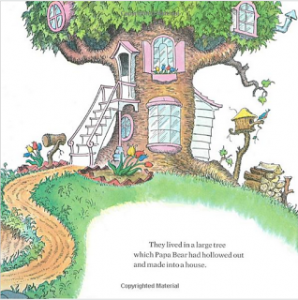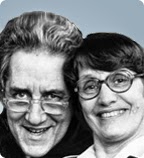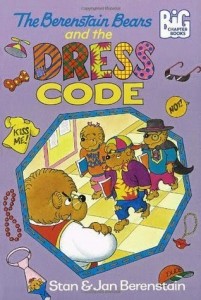The Berenstain Bear books bring up all sorts of warm memories. Those bears live the life I wish I had (treehouses and honeycomb, anyone?). The stories may be past their glory days but there are no other books with the same look or feel. The illustrations were how our house seemed to me when I was four. There were big trees to climb, wildflowers sprouting in every nook and cranny, a stream that ran alongside the road, and so on. I loved to leaf through the Berenstain Bear’s long before I could even read them. It was like a drawing of our home.
It was a heavily moralized series but most of the message was lost on me. The pages where the cubs act up are bright and detailed, while scenes depicting well-behaved cubs are tidy, orderly, and boring. I would purposely make my room as messy as possible to look as fun as the cubs’, and I’d never even heard of the Gimmies or how to throw a proper tantrum until the cubs taught me.
As an adult rereading these books to my kid, I’m noticing some plot points held constant through the series:
- Mama Bear enforces rules of behavior on the cubs
- The cubs are usually grappling with the same developmental issues even though Sister is younger than Brother
- Papa Bear is cheerful but absent. When he does try to be a disciplinarian he always loses his shit and starts yelling
- The story ends with Mama Bear calming everyone down and explaining what needs to be done to correct the behavior and/or situation
- Everyone is happy
Berenstain Bears offer a nice depiction of female authority in the family dynamic  in that Mama Bear is the voice of wisdom and Sister Bear is on the same maturity level as her older brother. Did Stan and Jan Berenstain set out to communicate this message?
in that Mama Bear is the voice of wisdom and Sister Bear is on the same maturity level as her older brother. Did Stan and Jan Berenstain set out to communicate this message?
I did some digging to figure this out.
Stan and Jan Berenstain worked as an artistic team from the time they were first married to the time of Stan’s death. They met in the Philadelphia Museum School of Industrial Arts in 1941 and jointly went off to help with the WWII war effort. Each contributed through their art: Stan as a medical illustrator at an army hospital and Jan as a draftsman for the Army Corps of Engineers (and as a riveter).
After the w ar they married with wedding rings that Jan made out of spare aluminum she collected while working on the Navy’s PBY Flying Boat. They submitted illustrations to McCall’s, the Saturday Evening Post, and Colliers Magazine among others. The Berenstain‘s published three books for adults and a comic strip in addition to the Bears series. They always collaborated together, except for instances later in life where their sons also contributed to Berenstain works.
ar they married with wedding rings that Jan made out of spare aluminum she collected while working on the Navy’s PBY Flying Boat. They submitted illustrations to McCall’s, the Saturday Evening Post, and Colliers Magazine among others. The Berenstain‘s published three books for adults and a comic strip in addition to the Bears series. They always collaborated together, except for instances later in life where their sons also contributed to Berenstain works.
These two were a team that highly valued the others talent, but did they purposely set out to convey a feminist message with their stories?
Neither Jan nor Stan explicitly stated whether or not they were feminist in interviews, but they did publish children’s books such as He Bear, She Bear, No Girls Allowed, and Mama Bear’s New Job, each of which champion equality of the sexes and portray discrimination against women as ridiculous. Plus they introduced an outright feminist character with Babs Bruno.
On the other hand, Mama Bear’s place is strictly in service to the family: she is completely desexualized; her outfit is shapeless and matronly to the max; she is widely drawn in domestic scenes; when she is out in public she is quiet and withdrawn; and she seems to put all of her time and energy into taking care of the kids.
So which is it? Is this a progressive series with accidental lapses into a 1950’s mentality or is it a conservative series that strongly endorses social equality? Is it damaging or empowering to read Berenstain Bears books to kids?
While a book is devoted to Mama Bear entering the workforce, there is great emphasis on the importance of her role as mother and wife. Her having a job is handled much the same way as The Simpsons handles Marge’s jobs. She’s a hard-working, able employee that is much better suited to be the breadwinner of the family, but without her industriousness and intelligence applied to their home life, their family will fall apart. Both Mama Bear and Marge are extremely capable and could have highly successful careers, but the place that most demands that resourcefulness is their homes.
This begs the question of whether or not being a homemaker is a fair use of a person’s talents. It’s a demanding job without vacation time or even the standard fifteen minute break per four hours. People who have to or choose to be homemakers should be paid by the government for their time and effort. It isn’t that being a mother or father isn’t genuine work, it’s that they are not paid for the labor. Can anyone flourish in a position so disregarded by society?
Sister Bear is spunky and rejects being left out of any activity for being a girl. If the boys start a secret hideout and won’t let her in, she makes her own hideout. In He Bear, She Bear she and Brother Bear demonstrate how boys and girls can do all of the same things. These are fine examples of gender-equality storylines, but they also plant ideas of gendered behavior in kids’ minds. No Girls Allowed introduces the concept of boys purposely leaving girls out in order to have more fun. Reading this may be the first encounter that a very young child has with sex segregation. He Bear, She Bear may be appropriate for kids who think boys and girls are only allowed to do designated activities, but reading it to a kid without that issue accomplishes nothing but suggesting the idea.
Babs Bruno, the feminist character, is hardly showcased in the series. The only book she takes a larger role in is The Berenstain Bears and the Dress Code, where she rallies against rules outlawing “rad dresses.” Having a character speak out against authority in books for young kids is great, but for it to be on such a cosmetic topic isn’t the most progressive story. Although Stan and Jan have both passed on, their sons have continued the series with Michael as a writer and Leo as a business manager. Mike initially contributed to the series in 1987 with The Day of the Dinosaur. In 1995 he created the Bear Scouts expansion to the Bears’ series, became his mother’s writing partner in 2005, then took over the entirety of the brand after Jan’s death in 2012. Mike has steered the series into an
Although Stan and Jan have both passed on, their sons have continued the series with Michael as a writer and Leo as a business manager. Mike initially contributed to the series in 1987 with The Day of the Dinosaur. In 1995 he created the Bear Scouts expansion to the Bears’ series, became his mother’s writing partner in 2005, then took over the entirety of the brand after Jan’s death in 2012. Mike has steered the series into an increasingly traditional direction with several new titles published in the new Living Lights mini-series. The books are steeped in Christian practice with emphasis on prayer, forgiveness, and respect for God’s will. While this religious approach does not explicitly endorse gender roles, it certainly does nothing to challenge sexism and continues to emphasize differences between Mama and Papa Bear.
increasingly traditional direction with several new titles published in the new Living Lights mini-series. The books are steeped in Christian practice with emphasis on prayer, forgiveness, and respect for God’s will. While this religious approach does not explicitly endorse gender roles, it certainly does nothing to challenge sexism and continues to emphasize differences between Mama and Papa Bear.
Many of their contrasting roles in Living Lights titles are communicated through the pictures rather than the text. While the family reminisces about their house in God Bless Our Home there is a flashback image of Papa Bear kicked back in an easy chair while Mama Bear folds clothes in a separate room. Mama Bear is never shown driving a car; she always sits passenger side to Papa Bear. Papa Bear is usually depicted relaxing indoors, doing physical projects outside, or enjoying sports like fishing and baseball. Mama Bear is depicted doing domestic chores and shopping; the most physical activity she does is gardening. Brother Bear’s activities are now portrayed as far more complex and boisterous than Sister Bear’s.
VS.
While Stan and Jan Berenstain always implemented morality lessons in their stories, it was never drawn from religious dogma. This approach originated with Mike Berenstain.
From The Christian Post:
While many fans have praised the books for teaching morality, Berenstain said his parents derived the lessons from “their own personal philosophy about raising children.” Berenstain said he and his older brother Leo were raised in a secular household.
“My father was a secular Jew; my mother was raised a nominal Christian,” he told The Christian Post. “We weren’t raised religious.”
Berenstain, who very much interested in science as a child, grew dissatisfied with his parents’ secular values. In college, he sought answers in philosophy. It was not until he married and sent his children to Quaker schools that he was introduced to the Bible. Berenstain said he then began to read the Bible and attend a local church.
The challenges the Bear family encounter have become increasingly serious with Mike in control, which has added weight to public reception of the series. Brother and Sister used to struggle with stage fright, fighting with friends, and moving; now they are grappling with honoring God and praying on a regular basis. It is impossible to deny that there is an intended moral code to the Living Lights mini-series, but Mike dismisses the idea.
In an interview, Mike Berenstain stated
We also have books about disabilities, diversity, gender equality and all kinds of positive behavioral cues… but we didn’t set out to establish any specific moral code or embed core values in the content. We actually had no intention of a “values” message or any one focal point, the Berenstain Bears are bits and pieces of our own life story. My parents started the series in 1962 as more of a “how to read” collection based on personal family experiences. It just shifted naturally toward ‘situations’ from things that took place firsthand, like The Berenstain Bears’ New Baby.
As Mike reminds us, Berenstain Bears have had a handful of pseudo feminist books (out of over two hundred titles). It’s possible that the underlying sexism of the series is unintentional. But regardless of whether or not the creators are subconsciously endorsing sexist depictions, the hint is being received by their audience. They are responsible for the messages of their work, no matter how subtle.
In the end, the Berenstain Bears is a conservative series that endorses gender equality but never makes it a main focus. Sexism is acknowledged as a social issue but is never fully explored. This missed opportunity has inadvertently introduced gender stereotypes through the text and imagery of the books. If kids want to read them, fine, but be ready to explain to them why Mama Bear wears that weird hat, why Papa Bear is always hanging out in his garage, and why boys don’t want to play with girls. After all, kids enacting gendered activities from reading No Girls Allowed is no different from four year old me purposely destroying my room after reading The Messy Room. Mike Berenstain’s new direction for the series leaves one wondering how far right the books will ultimately lean and what social problems this might cause for cubs- I mean kids.



